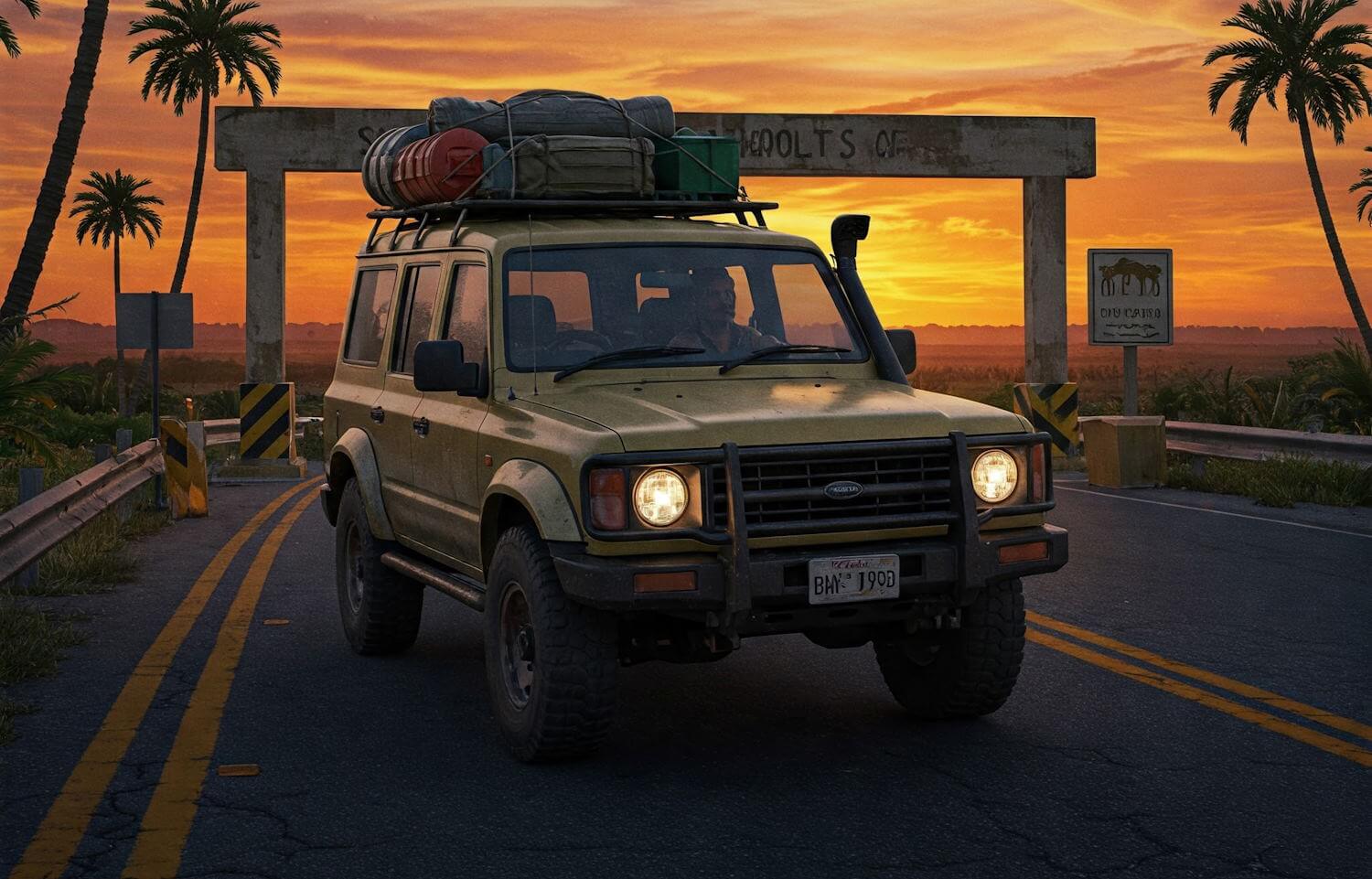Introduction to the Pan-American Highway
The Pan-American Highway, often regarded as the longest road in the world, spans approximately 19,000 miles, linking diverse landscapes and cultures from the northern reaches of Alaska in the United States to the southern tip of Argentina. This monumental route traverses through 14 countries, including notable nations such as Canada, Mexico, various Central American republics, and several countries in South America, weaving together a rich tapestry of history, culture, and natural wonders. The highway serves not only as a vital artery for trade and travel but also as a symbolic connection between the Americas.
Initially conceived in the late 19th century, the Pan-American Highway has evolved significantly over the years. Its historical importance cannot be understated, as it represents an ambitious vision of unity among the countries of the Americas. Travelers embarking on this journey will experience a plethora of distinct cultures, languages, and cuisines, each offering unique insights into the respective nations. From the majestic landscapes of the Rocky Mountains to the lush jungles of Central America, the route is rich in geographical diversity.
Moreover, the Pan-American Highway stands as a testament to human engineering, with its various segments showcasing different road conditions, from well-paved highways to more challenging terrains. The route encourages adventurers to embrace the spirit of exploration, as it has become a pilgrimage for many enthusiastic road-trippers seeking to witness the breathtaking beauty and rich heritage of the continent. Ultimately, driving the Pan-American Highway is not only about reaching a destination; it is about immersing oneself in an unforgettable journey across borders and cultures.
Planning Your Route: A Journey of a Thousand Miles
Embarking on an adventure along the Pan-American Highway requires meticulous planning to ensure a memorable and safe journey. The first step in this planning process is mapping out your itinerary. Begin by determining your starting point and final destination, as this will help you outline the key checkpoints along the way. The Pan-American Highway spans approximately 19,000 miles, traversing various terrains and climates, making it vital to have a clear understanding of the route you intend to take.
As you plan your route, consider including notable cities that you wish to visit. Each city along the highway reflects its unique culture, history, and attractions. For instance, starting in Anchorage, Alaska, you may want to include stops in Seattle, San Francisco, Los Angeles, and even onward to Mexico City, Guatemala City, and Bogotá. These cities not only offer essential services but also numerous local experiences that can significantly enhance your trip.
Researching local attractions and road conditions is equally important. Utilize reliable travel websites, forums, or local travel guides to gather information about various attractions, including historical sites, national parks, and scenic viewpoints. Understanding the road conditions, particularly in remote or less developed regions, can help you avoid unexpected challenges during your drive. Check for advisories on weather, maintenance work, or potential hazards that could impact your travel plans.
Moreover, it is crucial to stay informed about any travel restrictions in different regions. This can range from border crossing regulations to vaccination requirements. Being proactive in acquiring this information will contribute significantly to a smoother journey along the Pan-American Highway.
Preparations: Gear and Vehicle Considerations
Embarking on a journey along the Pan-American Highway requires meticulous preparations to ensure a successful and enjoyable adventure. One major consideration is the vehicle itself. A reliable and durable vehicle, such as a four-wheel drive SUV or a robust van, is highly recommended due to the varying terrains one will encounter, including mountains, deserts, and rainforests. It is essential to conduct a thorough inspection of the vehicle before departure. This includes checking the engine, brakes, tires, and lights, as well as ensuring that all fluids, including oil and coolant, are at optimal levels.
In addition to vehicle maintenance, having the right gear is crucial for a comfortable journey. A checklist of essential items should include camping equipment, such as a tent, sleeping bags, and portable cooking gear if you plan to camp along the way. It is also wise to pack sufficient clothing that caters to various weather conditions, as climates can drastically change from one region to another. Layering is a sensible approach, allowing for adjustments according to temperature fluctuations during the trip.
Safety must remain a priority throughout the drive. First aid kits, spare tires, and basic tools for repairs are fundamental. Additionally, investing in a high-quality navigation system ensures that you stay on track, as connectivity may vary in remote areas of the highway. Packing adequate food and water supplies is also crucial, particularly in regions where resources may be scarce. Integrating these considerations into your pre-trip checklist will enhance your preparedness, allowing you to focus more on the breathtaking landscapes and cultural experiences that the Pan-American Highway offers.
Cultural Encounters: Meeting the People Along the Way
Traveling along the Pan-American Highway is not merely a journey across landscapes; it is a rich tapestry of cultural encounters that provide profound insights into the societies you traverse. As you navigate through various countries spanning from the northern reaches of Alaska down to the southern tips of Argentina, you will come face to face with diverse communities, each boasting its unique traditions, languages, and ways of life.
Engaging with local people along this epic route enhances the overall travel experience and fosters a deeper understanding of regional cultural differences. From the Indigenous communities in Canada, whose ancestral knowledge spans thousands of years, to the vibrant Afro-Latino cultures in Central America, each interaction opens a window into the lifestyles and histories that shape these societies. Visitors may find opportunities to share stories over traditional meals, participate in local festivals, or learn artisanal crafts that have been passed down through generations.
Moreover, embracing cultural diversity while traveling contributes to more meaningful connections. Simple gestures, such as learning a few words in the local language or understanding significant customs, can lead to mutual respect and memorable exchanges. The unique traditions practiced in various regions — for instance, the colorful Dia de Muertos celebrations in Mexico or the hearty asado gatherings in Argentina — are not only enriching experiences for travelers but also maintain the cultural heritage of local communities.
Ultimately, the journey along the Pan-American Highway offers a rare opportunity to witness the interweaving of cultures. By stepping beyond the boundaries of mere observation and embracing authentic interactions, travelers can create meaningful memories that extend far beyond the landscapes they traverse. These encounters not only enhance personal experiences but also contribute to a greater appreciation of humanity’s shared diversity.
Natural Wonders: Scenic Stops Along the Route
Driving the Pan-American Highway is not merely a journey from one point to another; it is a breathtaking adventure filled with diverse natural wonders that showcase the beauty of the Americas. This extensive highway stretches across various landscapes, offering scenic stops that leave travelers in awe of nature’s grandeur. Each segment of the highway presents unique geological formations, national parks, and stunning vistas, all worthy of exploration.
In Canada, one of the first notable national parks along the route is Jasper National Park, known for its rugged mountains, pristine lakes, and extensive wildlife. Here, visitors can marvel at the stunning Athabasca Falls and take in the panoramic views from the Columbia Icefield. Transitioning southward into the United States, the iconic Rocky Mountain National Park offers majestic landscapes with towering peaks and expansive meadows, perfect for hiking and photography.
As the journey continues into Central America, travelers will find themselves in Costa Rica, which is renowned for its rich biodiversity. The Corcovado National Park, located on the Osa Peninsula, is home to an array of ecosystems and species found nowhere else on Earth. Its lush rainforests and pristine beaches provide a stunning backdrop for those looking to connect with nature.
Further along the Pan-American Highway, travelers will encounter the breathtaking landscapes of Patagonia in South America. The Torres del Paine National Park in Chile features dramatic granite peaks, turquoise lakes, and glaciers, creating a remarkable scenery for outdoor enthusiasts. This region is ideal for trekking, with well-marked trails leading to some of the most photogenic spots in the world.
In addition to these iconic locations, various lesser-known natural gems dot the route, each boasting their own unique charm. From the volcanic landscapes of Nicaragua to the lush plant life in the Amazon Basin, the Pan-American Highway is a gateway to explore the diverse environmental wonders of the continent. Every stop along the way contributes to an unforgettable experience, making the drive a true epic cross-continent adventure.
Challenges on the Road: Overcoming Obstacles
Traveling the Pan-American Highway presents a unique set of challenges that can test the mettle of even the most seasoned adventurers. One of the most immediate obstacles travelers may encounter are difficult road conditions. Portions of the highway, particularly in less developed areas, may feature potholes, gravel roads, or even sections that are unpaved. These factors can impede progress, necessitating careful planning regarding route selection and the type of vehicle used. A durable 4×4 vehicle is often recommended for navigating more rugged stretches.
Another significant challenge arises from language barriers. As travelers traverse various countries, the ability to communicate effectively can become increasingly difficult. While English is spoken in many tourist areas, proficiency in the local language can significantly enhance the travel experience and aid in resolving issues that arise. Tools such as translation apps can help bridge communication gaps, allowing for smoother interactions with locals and officials.
Unexpected weather changes can also pose a formidable challenge on this vast journey. Travelers should be prepared for a wide range of climates, from tropical conditions in Central America to colder temperatures in the Andes. Monitoring weather forecasts and being equipped with appropriate gear can make a significant difference in maintaining comfort and safety during unforeseen weather events.
Moreover, navigating border crossing regulations can be another source of frustration. Each country presents its own set of legal requirements regarding visas and vehicle permits, which can vary significantly. Thorough research is essential prior to embarking on the journey to ensure compliance with all necessary regulations and to avoid any delays.
Ultimately, the key to overcoming these obstacles lies in resilience and resourcefulness. Being adaptable and maintaining a positive mindset can transform these challenges into valuable aspects of the overall travel experience. With the right preparation and an open mind, travelers can turn potential difficulties into enriching adventures, cultivating unforgettable memories along the journey.
Food and Cuisine: A Culinary Journey
Traveling along the Pan-American Highway offers an unparalleled opportunity to indulge in a variety of culinary experiences that reflect the rich cultural tapestry of the Americas. Each region along this extensive route presents distinctive flavors and local specialties that can transform a simple journey into a memorable feast. From the fiery spices of Central America to the hearty dishes of Patagonia, the highway serves as a gastronomical adventure.
In Mexico, travelers can delight in the vibrant flavors of authentic tacos al pastor, accompanied by salsas that range from mild to spicy. Street food is a hallmark of Mexican cuisine, and indulging in tamales or elote from a street vendor is highly recommended. As you cross into countries like Guatemala, traditional dishes such as pepián, a flavorful meat stew, offer a glimpse into indigenous culinary practices.
The influence of colonial history becomes apparent in countries like Peru, where the fusion of Spanish and indigenous ingredients gives rise to unique dishes. Ceviche, marinated fish often served with sweet potatoes and corn, is a must-try for any food enthusiast. Moreover, the culinary scene in Peru has received global recognition, thanks in part to the innovative approaches taken by local chefs.
As you continue south towards Chile and Argentina, you will encounter the tradition of asado—a social barbecue that emphasizes the importance of communal dining. This experience allows travelers not only to enjoy flavorful grilled meats but also to connect with local customs and hospitality. Additionally, the burgeoning wine regions of these countries offer a suitable pairing for every meal, accentuating the overall culinary experience.
From the rich stews of the Andes to the seafood delicacies of coastal regions, the diversity of food along the Pan-American Highway illustrates how integral cuisine is to understanding the culture and spirit of each country. Each meal tells a story, inviting travelers to savor their journey through taste.
Safety Tips for the Road: Staying Secure
Traveling along the Pan-American Highway offers breathtaking views and unique cultural experiences, yet ensures that travelers prioritize their safety. Vehicle safety starts with proper maintenance checks before embarking on the journey. Inspect tires, brakes, lights, and fluid levels to avoid mechanical failures, which are vital for a secure driving experience. Additionally, always carry spare parts, such as a tire repair kit and basic tools, to handle minor issues independently.
Personal security is equally important, particularly in regions where crime rates may be higher. It is advisable to stay informed about the areas you plan to visit by checking travel advisories and connecting with local residents for updated information. Keep your vehicle doors locked and windows raised, especially in urban areas. Conceal valuable belongings to discourage theft and consider using a discreet backpack for essentials. Moreover, utilizing GPS or offline maps can help in navigating unfamiliar territories and reduce unnecessary stops.
Health considerations are paramount during your journey. Ensure you have necessary vaccinations and carry a first-aid kit to address any medical emergencies on the road. Staying hydrated and consuming safe food is essential in preventing gastrointestinal issues that can disrupt travel plans. In addition, be aware of altitude sickness when traveling through mountainous regions and take necessary precautions.
When traversing different regions, familiarize yourself with local laws and customs as they vary significantly across nations. Understanding driving regulations and speed limits can prevent potential legal troubles, while also enhancing your overall travel experience. Lastly, always carry an emergency contact list, including local authorities and your country’s embassy, should any unforeseen situations arise.
By adhering to these safety tips and recommendations, travelers can enjoy a remarkable and secure adventure along the Pan-American Highway.
Conclusion: The Journey Ahead
In summation, traversing the Pan-American Highway is not merely a mode of transportation; it represents a transformative journey through diverse landscapes, rich cultures, and unique stories that characterize the Americas. The adventure begins with the thrill of departing from the northernmost point in Prudhoe Bay, Alaska, where pristine wilderness beckons travelers to embrace the rugged beauty of the Arctic. As the journey unfolds, one encounters a tapestry of environments ranging from snow-capped mountains to sun-drenched beaches, each region offering its own allure and charm.
The journey along the Pan-American Highway goes beyond the visual spectacle; it facilitates connections between people and cultures. Travelers engage with local communities, experiencing cultural traditions firsthand, altogether enriching their understanding of the world. Interactions with diverse inhabitants, from the Indigenous peoples of Canada to the vibrant cultures of Central America, enhance the travel experience, instilling a sense of global camaraderie and appreciation for diversity.
Furthermore, the stories encountered along the way, whether they be of historical significance or personal journeys, contribute significantly to the overall appeal of this adventure. Each mile of the Pan-American Highway unveils narratives that resonate with the human experience, challenging travelers to reflect on their own life paths and aspirations. The call of the open road encourages individuals to step out of their comfort zones, fostering a spirit of exploration that remains unmatched.
Ultimately, the Pan-American Highway is more than just a physical route; it is an invitation to embark on an adventure of a lifetime. Encouraging readers to take up the challenge and experience the captivating journey is paramount. Every traveler will undoubtedly discover not only the beauty of the landscapes but also the profound impact of those they meet along the way. Embrace this epic adventure, for there are countless memories waiting to be made on the Pan-American Highway.




